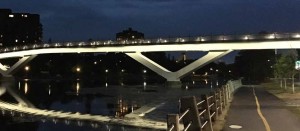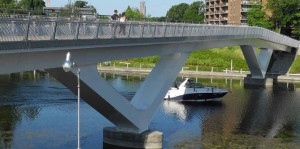
At night, the Flora Footbridge paints a brilliant streak across the Rideau Canal. Over the course of its brief existence, Flora has become one of the most popular photo subjects in the City. Photo by Cynthia Dwyer
John Dance
She’s now been very visibly with us for more than a year.
The Flora Footbridge was officially opened last June and as of mid-June of this year, there were 722,411 trips across the Rideau Canal between Clegg Street in Old Ottawa East (OOE) and Fifth Avenue in the Glebe.
The bridge was built after decades of lobbying by the neighbouring communities. Now, it’s simply a part of Capital Ward’s fabric, tying OOE and the Glebe together and making it easier, safer and more enjoyable for Ottawa pedestrians and cyclists to get across the mid-town section of the Canal.
In terms of use, the bridge has met expectations. Its environmental assessment forecast 1,500 to 2,500 daily trips and it’s averaged 2,058, although this varies greatly month to month. This past
May there was an average of 3,401 per day while in February there were only 701 per
day.
Numbers aside, the bridge has positively altered the daily patterns of residents. Many commuting, shopping and social trips now go via the bridge rather than over the Pretoria or Bank
Street bridges.
And with the profound impacts of the pandemic, residents have become urban adventurers with Glebe-ites safely exploring OOE and Old Ottawa South and vice versa. As per the reaction of users in our special Letters to the Editor section of this issue of The Mainstreeter, young families have become regular users as they sample the parks on both sides of the Canal.
“The Flora Footbridge has reduced the distance between two important mid-town Ottawa communities and has improved access for all users of the city’s extensive network of multi-use pathways,” Heidi Cousineau, the city’s acting director, transportation planning, told The Mainstreeter .
“The footbridge was built in keeping with the distinctive location and historic significance of the area and will allow for the continued enjoyment of the Rideau Canal in all seasons, while providing important connections for cyclists and pedestrians. With landscaping and public art (including benches) on both sides of the canal, the Flora Footbridge will be enjoyed by Ottawa residents for years to come.”

Pleasure crafts and pedestrians mix easily and often below and atop the Flora Footbridge. Photo by John Dance
During the lengthy consultations on the desirability of the bridge and its design, many worried that the bridge would turn Old Ottawa East into a parking lot when there were large events at Lansdowne Park. Yet, the experience so far is that while use of the bridge jumps when there is a Redblacks game or other major activity at the park, there is limited additional parking on streets near the OOE end of the bridge.
One less positive impact is the bridge abutment and ramp on the Old Ottawa East side. “I think the bridge is lovely,” said OOE resident John Graham, but he went on to say, “Unfortunately the guy
who designed it seems to have spent most of the money on the bridge, and then got his wife’s cousin to design the ramp on the Clegg side. I can’t imagine how sad and annoyed the people who live in its shadow feel.”
During the design process, the Old Ottawa East Community Association asked that the city use slender columns to support the ramp and the eastern end of the main span, but the city chose to have the space closed off. Some of the residents now behind the ramp and the abutment negotiated a solution with the City to get “top down bottom up blinds with a sheer component so that our privacy was not being compromised,” says Echo Drive resident Margaret Vant Erve.
“This has turned out to be a really good solution. As to the landscaping, we do find it rather
uninspiring on our side, but at least they have the underground watering system in place and it is maintained so in time, it will restore some of the greenery that we lost.”
Another point of contention was the sharp turn on the eastern switchback ramp. Residents wanted more space to make the turn, but the city said this wasn’t possible. Furthermore, staff said
the tight design would force cyclists to slow down and this would reduce collisions. The turn remains an awkward, even dangerous, part of the design but it is now well-signed to advise cyclists to yield to pedestrians and to slow down.
However, this spring, a 12-year-old OOE boy required several stitches after his arm brushed the snow-plow damaged railing. When the city was informed of the hazard, it immediately repaired the
railing.

In the midst of pandemic anxiety and BLM awareness, the message “You are loved!!!” appeared in pastel chalk on the OOE-side abutment. Photo by John Dance
Aside from the much-improved accessibility that the bridge provides, there have been two other notable benefits. The first is that the bridge serves as a vital public space where people can
meet, chat and, on occasion, even picnic or enjoy fireworks or the Snowbirds flying overhead.
The second is that the bridge provides a superb vantage point to take in the beauty of the Rideau Canal.
“I am thrilled that so many people love this bridge as much as I do,” says David Chernushenko, the former Capital Ward councillor who championed the footbridge at City Hall. “It is practical
and elegant. People do literally stop me in the street to praise the bridge and thank me for my role in it. It’s nice to hear after all the work that went in to it. I try to remember to add that it was a team effort with many contributors over many years.”
One complaint that Chernushenko hears is that the stairs are closed in winter.
“We knew from the outset that most City staircases are not maintained in winter; a
factor of liability and cost,” he says. “The good news is that this is something that
might be changed, with enough pressure from users.
The bridge was forecast to cost $21 million but was built for $2 million less. The bulk of the funding was provided through the efforts of MP Catherine McKenna ($10.5 million) and those of
former MPP Yasir Naqvi ($6.9 million)






